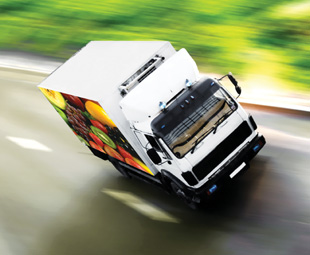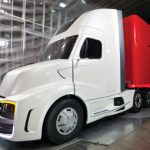Keeping it fresh

Delivering perishables on a large scale while trying to mix loads for optimal supply chain efficiency is a particularly challenging aspect of retail distribution. CLAIRE RENCKEN explains why, and how the challenge can be addressed.
The food and beverage distribution business is certainly not for the faint hearted. Reliable transport is vital, and managing large fleets of grocery distribution vehicles is a demanding job – especially when perishables are involved.
According to Imperial Logistics, a leading supplier of logistics and distribution services, recent developments, such as investments in centralised distribution infrastructure and the adoption of green practices in new store openings, have helped to overcome supply chain challenges in the South African retail sphere.
Imperial has identified some key supply chain management challenges that South African food retailers need to get to grips with:
• Back door delays;
• Eliminating time wastage, ensuring that fleets do not run empty;
• Combining of loads and product types;
• Combining deliveries for stores in the same area;
• Scheduling of deliveries in off peak periods to avoid traffic;
• Full capacity utilisation of vehicles; and
• Reducing the carbon footprint.
There has been increased investment in centralised distribution by food retailers this year, including the likes of Pick n Pay and Food Lover’s Market. This will result in the retailers “owning” more of the supply chain and is a threat to the sustainability of other outsourced distribution centres. Retailers will have more power as the majority of products will be distributed through their own centres; this will afford them the scope and scale. The principle of centralised distribution should ensure a leaner route to market, and thus cheaper distribution.
Food retailers are also moving towards more sustainable processes. Woolworths captures rain water to use in refrigeration in its Nicolway store in Bryanston, Johannesburg. The Falls Pick n Pay, due to open at the Atterbury Mall in Roodepoort, will employ daylight harvesting techniques. Transport service providers need to align with these sustainable processes. Imperial has pioneered a number of initiatives such as ecoFridge (see sidebar for more details), gas trucks and using environmentally friendly Euro-5 trucks. Multipurpose vehicles can do ambient, chilled, long-life and hanging-garment deliveries – and this flexibility can help to ensure that they don’t stand idle.
New shopping malls and retail developments are being built at an exponential rate, with grocery retailers opening stores in these outlets. One way for retailers to manage their supply chains to keep up with the number of new store openings and increased consumer demand is to outsource to service providers.
Such service providers should have sight of the typical new store opening schedule so they can align their resources to be able to cope in terms of:
• Extended receiving hours;
• Centralised distribution centres – greater control of stockholding and working hours; and
• Reduced congestion at store receiving areas.
The cold chain
A vital component of food and beverage distribution is temperature-controlled transport. It is essential that frozen and par-baked goods be kept within a specific temperature range during the supply and distribution chain. The slightest breakdown in the cold chain at any time can compromise the quality and freshness of the products, and even result in food poisoning at consumer level.
Refrigerated transport suppliers are obliged by law to comply with health and safety standards and regulations, including, and most importantly, ensuring that the cold chain is maintained from point of loading to point of delivery.
Efficient refrigerated transport is much more than simply fitting a fridge unit to an insulated trailer or van body. Meeting cold chain standards and the associated legal requirements demands a thorough understanding of:
• The product to be transported;
• The correct loading procedures;
• The optimal temperature at which perishable products should be transported;
• The optimal design and specification for trailers or truck-mounted insulated boxes;
• The criteria for choosing a suitable and appropriate fridge unit;
• Optimal location of the evaporator(s) and temperature monitoring probes;
• Unloading procedures;
• Maintenance of equipment;
• Training of schedulers, warehouse personnel (loaders and checkers), drivers and crew; and
• Ongoing communication with shippers, agents and the recipient of the goods.
Where products are transported at different temperatures within the same vehicle, it is imperative that the products and refrigerated truck or trailer are pre-cooled to the required temperature prior to loading.
Keeping refrigeration motors running while the vehicle is being offloaded simply has the effect of pumping the cold air out of the vehicle, allowing warm air to be sucked in. This can cause the fridge motor to switch to a defrost cycle, resulting in a drop in temperature. A solution to this problem is a door switch that automatically switches the motor off as soon as the doors are opened. This effectively reduces the cold air loss, and can be improved further if a PVC air curtain is fitted behind the doors.
Separating dry goods from refrigerated goods will also improve temperature control and reduce cooler unit diesel consumption. Numerous load-divider options are available, and can be used in conjunction with a multi-temperature cooler unit to accommodate almost any combination of temperature band within a vehicle body. Making certain that air flow isn’t restricted will help to maintain optimum air circulation and ensure that the vehicle doesn’t have “hot spots”. A simple way to improve air flow is to stack the product onto pallets.
Today’s consumer doesn’t just demand a fair price for fresh and frozen goods, but also expects high quality with a reasonable shelf life. As a result, stores are getting more involved in checking the quality of the product when it arrives. So there is now more pressure on the transporters of fast moving consumer goods; delivery needs to be on time, at the right temperature, and in the right condition.
A cool innovation
Higher consumer expectations, along with an increasing focus on sustainability, are changing the landscape of the refrigerated transport industry. Imperial Logistics Refrigerated Services, together with renowned South African brands such as Woolworths, has made significant inroads in greening transportation refrigeration.
One initiative is its investment in three semi-trailers, with one rigid unit equipped with the ecoFridge. Fundamentally different from mechanical refrigeration systems, ecoFridge is nitrogen-powered and therefore completely harmless to the environment. It is also 30 percent more cost effective to operate. There is the added benefit of the absence of noise pollution when using these nitrogen-based units. The ecoFridge even outperforms conventional fridge units in some areas, boasting quicker cool-down capabilities than conventional fridge systems.
These units also record temperature very accurately. In addition, the ecoFridge ensures that the moisture in the air is maintained, as opposed to conventional units that effectively dry out the air.
Published by
Focus on Transport
focusmagsa




